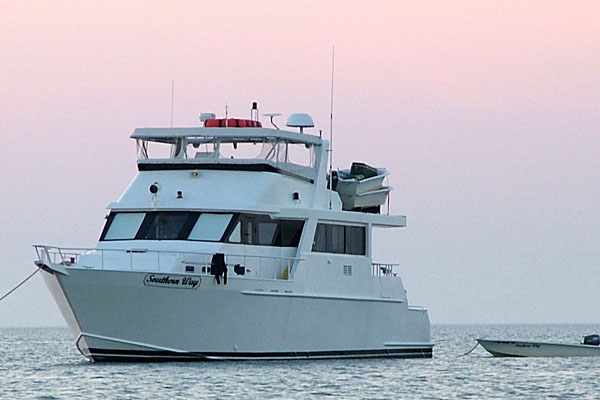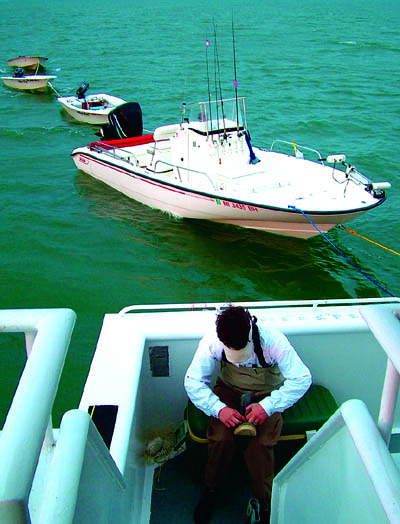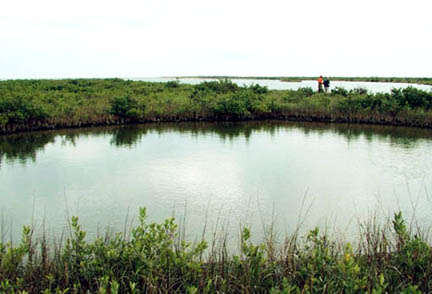
The Saltwater Magazine for Gulf Coast Fishing!
FISHING FORECASTS
| FISHING CALENDARS | ARTICLES | ADVERTISE
| SUBSCRIBE
Search Gulf Coast Fisherman's
Web Site
Past articles, specific
places or fish, etc.

by Al Rogers
| CURRENT
MOON lunar phases |
- Soon the Chandeleurs will be reduced to
sand shoals and fond memories.....

Thirty-five miles off the coast of Biloxi, Mississippi, a waning crescent moon cast a faint glimmer across the dark waters of the Gulf of Mexico. Millions of stars were strewn across an endless sky. I realized a remarkable resemblance that the moon had to an area where I was anchored the Chandeleur Islands. The shapes were almost identical. And much like this bright thin sliver in the night, the fading celestial body in the distance, this barrier island chain, is in its final phase.
The Chandeleurs have likely saved many lives, acting as a defense "barrier," that absorbs the initial impacts of tropical weather systems. But these islands are also prolific environs where hundreds of species of finfish, crustaceans and wildlife flourish. The heavily vegetated interiors of this fragmented chain are veritable sanctuaries where juvenile fish, crabs and shrimp can find protective cover, increasing their odds of survival.
The islands and surrounding waters here are pristine - untouched. For generations recreational anglers have come here to enjoy world-class fishing. From the stern of the "Southern Way," a 72-foot luxury yacht, I watched as the glimmer in the night sky faded.
The moon will reemerge brighter, and fuller. But geologists don't believe this will be the case for the islands. It was a sobering experience because I realized that except for the endless skies that I watched, nothing is forever.
There is birth, life and death, and everything changes.
The islands have taught me much about fishing, conservation, and a deep respect for nature. I've learned that if you attune yourself to your surroundings here, you can feel her dynamic forces at work the wind and wave action, the ebb and flow of tides, and grains of sand shifting on the seafloor beneath your feet. The islands are in a constant state of flux.
Researchers with the U.S. Geological Survey (USGS) have concluded that the Chandeleur Islands are dying. The most visible changes have occurred in the last six years. But the process did not begin with hurricanes Betsy, Camille, Katrina, Georges or Ivan. The slow demise of the Chandeleurs actually began about 2,000 years ago when the mouth of the Mississippi River left the St. Bernard Delta and moved to its present location south of Venice.
My first trip to the Chandeleur Islands was with my father in 1974. I
recall climbing to the peaks of monstrous sand dunes to see land masses
that literally stretched as far as the eye  could see. And
I also remember catching huge trout and redfish on nearly every cast with
Dad's old box of shad rigs and Bingos.
could see. And
I also remember catching huge trout and redfish on nearly every cast with
Dad's old box of shad rigs and Bingos.
Records indicate that in those days the Chandeleurs stretched for more than 75 miles. But by 2001 the islands ran 57 miles from the lighthouse south to Breton Island. The islands continued to deteriorate and were cut to less than 25 miles after Hurricane Ivan in 2004. Today the islands are now less than 11 miles long. Geologists believe Katrina may have been the coup de grace that pushed these islands over the edge.
Soon the Chandeleurs will be reduced to sand shoals and fond memories.
Big Changes
The Chandeleur Islands were created some 4,000 years ago when the mouth of the Mississippi River discharged into an area just east of present day New Orleans. Deposits of nutrients and sediment carried by the river created an offshore paradise that stretched from the Mississippi Gulf Coast to the new Mississippi River Delta off the coast of southeast Louisiana.
Few fished these barrier islands until the early 20th Century when several charter boat operations began making short runs to Ship Island, Cat Island and Petit Bois islands. As the for-hire or "head boat" industry became more competitive in the 1930s, some captains began making exclusive trips to this crescent shaped island chain where anglers returned with boxes and tales of monster specks and reds.
The changes to the industry and the islands have been profound. Gone are the Biloxi luggers that once ferried passengers to the islands. I often wonder what charter trips and the islands were like back then. The Chandeleurs encompassed hundreds of thousands of miles. One can only imagine what it looked like on February 1, 1700 when Pierre Le Moyne Sieur d'Iberville anchored here and named the islands.
Much of the landmass has been lost. But what is left is truly paradise. And I would soon learn that the fishing here is as good as it ever was.
"We were relieved that the islands were still here," said Capt. Bart Haddard, co-owner of the Southern Way. "We'd heard all of these stories and we weren't really sure if there would be anything left."
Although abbreviated by Katrina's wrath, the remnants of the islands are more beautiful that I imagined. Mangroves and eelgrass cover the sand and shell islands and exotic birds nest in the sanctuaries. Flocks of seagulls feasted on shrimp and baitfish in the interior bayous and cuts. The waters were so clear that I could see beds of sea grass five feet down.
"A lot has changed," said Capt. Drew Dekle, who oversees fishing on the Southern Way. "Over there is where the lighthouse should be."
Dekle was one of the last to leave the islands as Hurricane Katrina churned in the Gulf last summer. As he rounded the northern tip of the island, Dekle shot a photo of the Chandeleur Island lighthouse. This photo was the last documented evidence of the lighthouse, which has stood since 1895.
Barrier islands like the Chandeleurs are dynamic entities that constantly shift, build and erode under the normal actions of winds and waves. But the great force and magnitude of Hurricane Katrina produced dramatic changes to the islands that would have otherwise taken years, maybe decades to reach.
"The fish are still here," he said. "It's incredible. You're getting ready to find out."
World-class fishing
Dekle, a New Orleans native who has lived in Bay St. Louis since 1992, knowsthis chain of islands as well as most of the salty old veterans on the Gulf Coast. And he is fortunate to captain one of the finest and most luxurious fishing vessels on the Gulf. The Southern Way offers multi-day expeditions to many destinations in the region. But their specialty is barrier island fishing.
Dekle said the northern and southern ends of the islands sustained the greatest losses in the latest hurricanes. We set our course to the middle section of the Chandeleurs an area Dekle believes is the most productive. By noon the Southern Way anchored at a drop off marked on maps as Catch 'Em All Bar. Other nearby areas are Old Schooner Harbor, New Schooner Harbor, Shrimp Boat Cut, Smuggler's Cove, Redfish Point and Hollywood Bayou.
On the way out we were joined by one of the co-owners of Southern Way Charters, Dr. Raymond Whitehead, a Hattiesburg, Mississippi-based orthopedic surgeon. Whitehead arrived in his personal 24-foot Boston Whaler bay boat.
Meanwhile, on the upper deck, mates Matt Tusa and Brian Gagnon were lowering 14-foot fiberglass skiffs into the emerald waters. The mothership carries six of these skiffs powered by 15-hp Yamaha outboards. Because of the ever-changing sand bars and shoals, these skiffs are really the only way to navigate the islands.
Whitehead, Tusa and Dekle left immediately for Freemason Island. This, the southernmost of the "back islands" of the Chandeleurs, is comprised of shell fragments from the indigenous species of mollusks. Freemason is considered to be one of the best areas to catch trophy speckled trout.
I wedged myself into neoprene waders, grabbed my camera and stepped into a skiff. I was surprised to find that it had already been packed with rods, reels, ice, drinks, a map of the area's hot spots, and a hand-held marine radio. I was headed toward North Island where I planned to work my way back.
Anglers here should remember that the islands are shifting and sinking rapidly. So be aware that shallow shoals surround the islands making navigation difficult. Southern Way Charters has several veteran guides on staff who frequently fish the area. If you are new to the area follow or take a guide with you.
My first stop was a cut in Redfish Point where I tight-lined plastics (Bass Assassin - salt/pepper/chartreuse) through schools of mullet. I attempted to concentrate on fishing but was so transfixed on the beauty of the islands I missed several fish. I then stepped onto the island to explore and take photos. After an hour I returned to the mothership.
As I stepped on board I began to realize what Southern Way hospitality was all about. Plumes of hickory smoke wafted from a large stainless steel grill at the stern. Down in the galley Haddad was cutting fresh rib eyes from a rack while a mate tossed a salad.
Haddad was right. A trip to the Chandeleurs is much more than fishing.
After a quick shower I helped select two bottles of fine wine and we strolled up to the aft deck for an incredible view of the islands at sunset.
"This afternoon we just scouted," he said. "Tomorrow we fish."
Just after sunset we saw the lights of Whitehead's Whaler in the distance. They apparently did more than just "scout," stepping aboard with two stringers of specks that evoked memories of the mules I caught here more than 30 years earlier. With a grin from ear to ear Tusa heaved a stringer of 14 specks on board. These fish were all in the three- to five-pound class.
"Got 'em all on topwaters," he said. "MirrOlures Top Dogs, She Dogs, anything we could throw at them. I just wish we had more time."
Whitehead and Dekle pulled in another stringer of 20 big specks. They used suspending walking baits such as the Catch 2000 and the Catch 5. The entire group wade fished, one of the historically preferred methods of fishing the islands.
It was an impressive afternoon catch. And Tusa said it all. I wish we all had more time to fish the Chandeleurs.
Mastering the Interiors
The next morning Dekle and I studied a map that he drew of the region. Winds were forecast to increase to 15 mph so we felt it was best to fish the protective interiors. The islands have been also described as a curved, multi-jointed spine. Within these "spines" are discs, or cuts and winding bayous that connect the Sound and the Gulf on the other side. The islands are infested with tall mangroves and dunes that block the wind.
 There are countless points and moving water,
regardless of the tidal movement.
There are countless points and moving water,
regardless of the tidal movement.
The hard sand and shell bottom makes it extremely easy to walk the islands. This is one of the reasons generations of anglers have enjoyed great wade fishing here.
Dekle, Haddard and I left for New Schooner Harbor. In this area there are winding bayous. We threw Saltwater Assassins in various colors and picked up two or three trout at nearly ever point we encountered. Dekle said these were typical spring patterns for the islands. Generally speaking from mid-March through late-April many of the trout will remain within the island interiors. But as water temperatures warm rapidly the fish migrate - but not far.
Throughout the summer, anglers will find vast schools of specks and reds in the shallower depths, such as the bars and shelves. This is when surf fishing peaks and limits are common.
"At this time of the year it's sometimes difficult to establish a pattern," Dekle said. "They're scattered in transition."
If throwing plastics, Dekle suggests using a variety of retrieves and weighted jigheads to find the strike zone. He rarely uses live bait but carries a cast net just in case.
The action on 14- to 16-inch trout remained consistent for another hour. Then came an excited voice on the radio. It was Tusa and Gagnon. They had found big trout in an area about a mile from us to the south. As we arrived we carefully navigated our skiff over a massive sand shoal that blocked the entrance of the cut. For the final 300 yards we stepped out and pulled the boat to shore.
Here was a channel that came to a dead end at the surf. There was a landmass in the middle. As the tide rushed in it pushed shrimp and baitfish into the mangrove-covered mound. The forage apparently became disoriented as the currents slammed them into the landmass. And we could see huge black predators were laying in wait, ambushing the juvenile finfish every chance they got.
It was exactly as they had described sheer pandemonium. With a hookup on
almost every cast the trio was catching specks in the 3 to 5-pound class. We headed back to the Southern Way by mid-afternoon with lots of fish and enough memories to last a lifetime. It was one of the most enjoyable trips I can ever remember.
I only wish we had more time.
See the Chandeleurs
There may be no better time than to schedule an expedition to the Chandeleur Islands. Southern Way Charters (601) 299-0726 offers all-inclusive trips all of the barrier islands and even the Biloxi Marsh. The crew is courteous and professional and can fulfill any wishes or needs or their clients. Special rates and packages for corporate trips, family trips, even bachelor parties are available.
The Southern Way can comfortably accommodate up to 12 guests in six staterooms. The all-aluminum hull is battleship sturdy and has creature comforts such as full heads with showers, central air and heat, a full galley with chefs, satellite television capable of picking up virtually any sporting event, satellite radio and a state-of-the-art communications system.
Southern Way Charters offers guests comfortable, private rooms, fantastic meals and the best tackle and boats available. Guests can bring their own tackle if they wish. Because you will likely want to get out of the boat to fish or explore these pristine islands it's a good idea to bring neoprene waders. These can be purchased in the sporting goods departments at most major retail stores for about $50.
Other necessary items are a hat, insect repellent, sunscreen and a Louisiana saltwater fishing license. There is so much more than great fishing at the Chandeleur Islands. So don't forget your camera. For scheduling and other information contact Southern Way Charters at (601) 299-0726.


